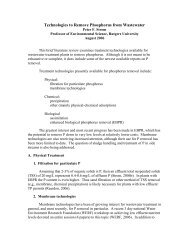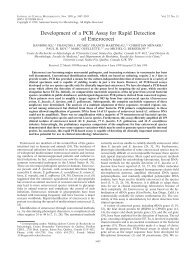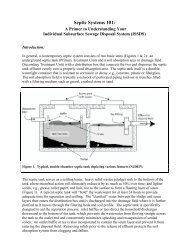Rain Gardens - A how-to manual for homeowners - The Learning ...
Rain Gardens - A how-to manual for homeowners - The Learning ...
Rain Gardens - A how-to manual for homeowners - The Learning ...
Create successful ePaper yourself
Turn your PDF publications into a flip-book with our unique Google optimized e-Paper software.
A <strong>how</strong>-<strong>to</strong> <strong>manual</strong><br />
<strong>for</strong> <strong>homeowners</strong>
Your personal contribution <strong>to</strong> cleaner water<br />
Homeowners in many parts of the country are catching on <strong>to</strong> rain gardens – landscaped<br />
areas planted <strong>to</strong> wild flowers and other native vegetation that soak up rain water,<br />
mainly from the roof of a house or other building. <strong>The</strong> rain garden fills with a few inches<br />
of water after a s<strong>to</strong>rm and the water slowly filters in<strong>to</strong> the ground rather than running off<br />
<strong>to</strong> a s<strong>to</strong>rm drain. Compared <strong>to</strong> a conventional patch of lawn, a rain garden allows about<br />
30% more water <strong>to</strong> soak in<strong>to</strong> the ground.<br />
Why are rain gardens important? As cities and suburbs grow and replace <strong>for</strong>ests and<br />
agricultural land, increased s<strong>to</strong>rmwater runoff from impervious surfaces becomes a<br />
problem. S<strong>to</strong>rmwater runoff from developed areas increases flooding; carries pollutants<br />
from streets, parking lots and even lawns in<strong>to</strong> local streams and lakes; and leads <strong>to</strong> costly<br />
municipal improvements in s<strong>to</strong>rmwater treatment structures.<br />
By reducing s<strong>to</strong>rmwater runoff, rain gardens can be a valuable part of changing these<br />
trends. While an individual rain garden may seem like a small thing, collectively they<br />
produce substantial neighborhood and community environmental benefits. <strong>Rain</strong> gardens<br />
work <strong>for</strong> us in several ways:<br />
g<br />
g<br />
g<br />
g<br />
g<br />
Increasing the amount of water that filters in<strong>to</strong> the ground, which<br />
recharges local and regional aquifers;<br />
Helping protect communities from flooding and drainage problems;<br />
Helping protect streams and lakes from pollutants carried by<br />
urban s<strong>to</strong>rmwater – lawn fertilizers and pesticides, oil and<br />
other fluids that leak from cars, and numerous<br />
harmful substances that wash off roofs and<br />
paved areas;<br />
Enhancing the beauty of yards and neighborhoods;<br />
Providing valuable habitat <strong>for</strong> birds, butterflies<br />
and many beneficial insects.<br />
2
Who should use this<br />
<strong>manual</strong>?<br />
This <strong>manual</strong> provides<br />
<strong>homeowners</strong> and landscape<br />
professionals with the<br />
in<strong>for</strong>mation needed <strong>to</strong><br />
design and build rain<br />
gardens on residential lots.<br />
Guidelines presented in this<br />
<strong>manual</strong> can also be used <strong>to</strong><br />
treat roof runoff at commercial<br />
and institutional<br />
sites. However, the <strong>manual</strong><br />
should not be used <strong>to</strong><br />
design rain gardens <strong>for</strong><br />
parking lots, busy streets<br />
and other heavily used<br />
paved areas where<br />
s<strong>to</strong>rmwater would require<br />
pretreatment be<strong>for</strong>e<br />
entering a rain garden.<br />
Frequently asked questions<br />
Does a rain garden <strong>for</strong>m a pond?<br />
No. <strong>The</strong> rain water will soak in so the rain garden is dry<br />
between rainfalls. (Note: some rain gardens can be<br />
designed <strong>to</strong> include a permanent pond, but that type of<br />
rain garden is not addressed in this publication).<br />
Are they a breeding ground <strong>for</strong> mosqui<strong>to</strong>es?<br />
No. Mosqui<strong>to</strong>es need 7 <strong>to</strong> 12 days <strong>to</strong> lay and hatch eggs,<br />
and standing water in the rain garden will last <strong>for</strong> a few<br />
hours after most s<strong>to</strong>rms. Mosqui<strong>to</strong>es are more likely <strong>to</strong> lay<br />
eggs in bird baths, s<strong>to</strong>rm sewers, and lawns than in a<br />
sunny rain garden. Also rain gardens attract dragonflies,<br />
which eat mosqui<strong>to</strong>es!<br />
Do they require a lot of maintenance?<br />
<strong>Rain</strong> gardens can be maintained with little ef<strong>for</strong>t after the<br />
plants are established. Some weeding and watering will be<br />
needed in the first two years, and perhaps some thinning<br />
in later years as the plants mature.<br />
Is a rain garden expensive?<br />
It doesn’t have <strong>to</strong> be. A family and a<br />
few friends can provide the labor. <strong>The</strong><br />
main cost will be purchasing the plants,<br />
and even this cost can be minimized by<br />
using some native plants that might<br />
already exist in the yard or in a<br />
neighbor’s yard.<br />
<strong>Rain</strong> <strong>Gardens</strong> – A <strong>how</strong>-<strong>to</strong> <strong>manual</strong> <strong>for</strong> <strong>homeowners</strong> 3
• • • • • Step 1<br />
Sizing and Siting the <strong>Rain</strong> Garden<br />
This section of the <strong>manual</strong> covers rain garden<br />
basics – where <strong>to</strong> put the rain garden,<br />
<strong>how</strong> big <strong>to</strong> make it, <strong>how</strong> deep <strong>to</strong> dig it, and<br />
what kind of soils and slope are best. Following<br />
the instructions in this section is the best way<br />
<strong>to</strong> ensure a successful rain garden project.<br />
An extension of PVC pipe helps direct downspout water<br />
<strong>to</strong> this rain garden.<br />
If you already know the size you want your rain<br />
garden <strong>to</strong> be, then skip ahead <strong>to</strong> the section<br />
about building the rain garden. However, take time read the pointers about location, and<br />
do find the slope of the lawn. If the location has a slope more than about 12%, it’s best <strong>to</strong><br />
pick a different location because of the ef<strong>for</strong>t it will take <strong>to</strong> create a level rain garden.<br />
Where should the rain garden go?<br />
Home rain gardens can be in one of two places – near the house <strong>to</strong> catch only roof runoff or farther out on<br />
the lawn <strong>to</strong> collect water from the lawn and roof. (Figure 1 s<strong>how</strong>s the possible locations on a residential lot.)<br />
To help decide where <strong>to</strong> put a rain garden, consider these points:<br />
• <strong>The</strong> rain garden should be at least 10 feet from the house so infiltrating water doesn’t<br />
seep in<strong>to</strong> the foundation.<br />
• Do not place the rain garden directly over a septic system.<br />
• It may be tempting <strong>to</strong> put the rain garden in a part of the yard where water already<br />
ponds. Don’t! <strong>The</strong> goal of a rain garden is <strong>to</strong> encourage infiltration, and your yard’s wet<br />
patches s<strong>how</strong> where infiltration is slow.<br />
• It is better <strong>to</strong> build the rain garden in full or partial sun, not directly under a big tree.<br />
• Putting the rain garden in a flatter part of the yard will make digging much easier.<br />
For example, a rain garden 10 feet wide on a 10% slope must be 12 inches deep <strong>to</strong> be<br />
level, unless you import <strong>to</strong>psoil or use cut and fill.<br />
4
Consider your overall landscape<br />
When considering placement of your rain<br />
garden, design with the end in mind.<br />
Carefully consider <strong>how</strong> the rain garden can<br />
be integrated in<strong>to</strong> existing and future<br />
landscaping. Also, pay attention <strong>to</strong> views<br />
from inside the house as well as those<br />
throughout the landscape. Determine <strong>how</strong><br />
far or <strong>how</strong> close you want your rain garden<br />
<strong>to</strong> outdoor gathering spaces or other play<br />
areas. Why not locate it near a patio where<br />
you can take advantage of the colors and<br />
fragrances <strong>for</strong> hours on end!<br />
Figure 1 A rain garden can<br />
be built in the front or back<br />
yard. Pick a pleasing shape<br />
<strong>for</strong> the rain garden. Crescent,<br />
kidney, and teardrop shapes<br />
seem <strong>to</strong> work well.<br />
not within 10'<br />
of foundation<br />
rain garden<br />
length<br />
> 30'<br />
from<br />
down spout<br />
rain<br />
garden<br />
width<br />
roof and lawn<br />
drainage<br />
area <strong>to</strong> back<br />
rain garden<br />
roof drainage<br />
area <strong>to</strong> front<br />
rain garden<br />
close <strong>to</strong><br />
down spout<br />
rain<br />
garden<br />
width<br />
rain garden<br />
length<br />
street<br />
<strong>Rain</strong> <strong>Gardens</strong> – A <strong>how</strong>-<strong>to</strong> <strong>manual</strong> <strong>for</strong> <strong>homeowners</strong> 5
10'<br />
from<br />
foundation<br />
Figure 2 <strong>Rain</strong> gardens should<br />
be located at least 10 feet from<br />
the house, on a gentle slope<br />
that catches downspout water.<br />
berm<br />
> 30'<br />
from<br />
down spout<br />
close<br />
<strong>to</strong><br />
down<br />
spout<br />
berm<br />
< 12%<br />
slope<br />
street<br />
How big should the rain garden be?<br />
<strong>The</strong> surface area of the rain garden can be almost any size, but time and cost will always be important considerations<br />
in sizing decisions. Any reasonably sized rain garden will provide some s<strong>to</strong>rmwater runoff control.<br />
A typical residential rain garden ranges from 100 <strong>to</strong> 300 square feet. <strong>Rain</strong> gardens can be smaller than 100<br />
square feet, but very small gardens have little plant variety. If a rain garden is larger than 300 square feet it<br />
takes a lot more time <strong>to</strong> dig, is more difficult <strong>to</strong> make level, and could be hard on your budget.<br />
<strong>The</strong> size of the rain garden will depend on<br />
• <strong>how</strong> deep the garden will be,<br />
• what type of soils the garden will be planted in, and<br />
6<br />
• <strong>how</strong> much roof and/or lawn will drain <strong>to</strong> the garden.<br />
This in<strong>for</strong>mation, along with the sizing fac<strong>to</strong>r from the tables on<br />
page 9, will determine the surface area of the rain garden.<br />
Digging with a rented backhoe.<br />
Guidelines are not rules…<br />
<strong>The</strong> sizing guidelines<br />
described in this <strong>manual</strong> are<br />
based on a goal of controlling<br />
100% of the runoff <strong>for</strong> the<br />
average rainfall year while<br />
keeping the size of the rain<br />
garden reasonable. Establishing<br />
a 100% runoff goal helps<br />
compensate <strong>for</strong> some of the<br />
errors that creep in<strong>to</strong> the<br />
design and construction of<br />
any rain garden.<br />
If you follow the guidelines in<br />
the <strong>manual</strong> and decide the<br />
calculated surface area is just<br />
<strong>to</strong>o large <strong>for</strong> your goals, it is<br />
perfectly acceptable <strong>to</strong> make<br />
the rain garden smaller. <strong>The</strong><br />
rain garden can be up <strong>to</strong> 30%<br />
smaller and still control almost<br />
90% of the annual runoff. On<br />
the other hand, it is fine <strong>to</strong><br />
make the rain garden bigger<br />
than the guidelines indicate.
How Deep Should the <strong>Rain</strong> Garden Be?<br />
A typical rain garden is between four and eight inches deep. A rain garden more than eight inches deep<br />
might pond water <strong>to</strong>o long, look like a hole in the ground, and present a tripping hazard <strong>for</strong> somebody<br />
stepping in<strong>to</strong> it. A rain garden much less than four inches deep will need an excessive amount of surface<br />
area <strong>to</strong> provide enough water s<strong>to</strong>rage <strong>to</strong> infiltrate the larger s<strong>to</strong>rms.<br />
No matter what the depth of<br />
the rain garden, the goal is <strong>to</strong><br />
keep the garden level. Digging<br />
a very shallow rain garden on a<br />
steep lawn will require bringing<br />
in extra <strong>to</strong>psoil <strong>to</strong> bring the<br />
downslope part of the garden<br />
up <strong>to</strong> the same height as the<br />
up-slope part of the garden. As<br />
the slope gets steeper, it is easier<br />
<strong>to</strong> dig the rain garden a little<br />
deeper <strong>to</strong> make it level.<br />
downhill<br />
stake<br />
height<br />
width<br />
the string must be level<br />
Figure 3 <strong>The</strong> string should be tied <strong>to</strong><br />
the base of the uphill stake, then tied <strong>to</strong><br />
the downhill stake at the same level.<br />
uphill<br />
stake<br />
<strong>The</strong> slope of the lawn should determine the depth of the rain garden. Find the slope of your lawn by<br />
following these steps. (Figure 3 s<strong>how</strong>s <strong>how</strong> the stakes and string should look.)<br />
1. Pound one stake in at the uphill end of your rain garden site and pound the other stake<br />
in at the downhill end. <strong>The</strong> stakes should be about 15 feet apart.<br />
2. Tie a string <strong>to</strong> the bot<strong>to</strong>m of the uphill stake and run the string <strong>to</strong> the downhill stake.<br />
3. Using a string level or the carpenter’s level, make the string horizontal and tie the string<br />
<strong>to</strong> the downhill stake at that height.<br />
4. Measure the width (in inches) between the two stakes.<br />
5. Now measure the height (in inches) on the downhill stake between the ground and string.<br />
6. Divide the height by the width and multiply the result by 100 <strong>to</strong> find the lawn’s percent<br />
slope. If the slope is more than 12%, it’s best <strong>to</strong> find another site or talk <strong>to</strong> a professional<br />
landscaper.<br />
Using the slope of the lawn, select the depth of the rain garden from the following options:<br />
✓<br />
EXAMPLE<br />
• If the slope is less than 4%, it is easiest <strong>to</strong> build a 3 <strong>to</strong> 5-inch deep rain garden.<br />
• If the slope is between 5 and 7%, it is easiest <strong>to</strong> build one 6 <strong>to</strong> 7 inches deep.<br />
• If the slope is between 8 and 12%, it is easiest <strong>to</strong> build one about 8 inches deep.<br />
Todd measures the length of the string between the stakes; it is 180 inches long. <strong>The</strong> height<br />
is 9 inches. He divides the height by the width <strong>to</strong> find his lawn’s percent slope.<br />
height x 100 =% slope<br />
width<br />
9 inches<br />
180 inches<br />
x 100 =5% slope<br />
With a 5% slope, Todd should build a 6 inch deep rain garden.<br />
<strong>Rain</strong> <strong>Gardens</strong> – A <strong>how</strong>-<strong>to</strong> <strong>manual</strong> <strong>for</strong> <strong>homeowners</strong> 7
What type of soils are on the rain garden site?<br />
After choosing a rain garden depth, identify the lawn’s soil type as sandy, silty, or clayey. Sandy soils have<br />
the fastest infiltration; clayey soils have the slowest. Since clayey soils take longer <strong>to</strong> absorb water, rain<br />
gardens in clayey soil must be bigger than rain gardens in sandy or silty soil. If the soil feels very gritty and<br />
coarse, you probably have sandy soil. If your soil is smooth but not sticky, you have silty soil. If it is very<br />
sticky and clumpy, you probably have clayey soil.<br />
How big is the area draining <strong>to</strong> the rain garden?<br />
<strong>The</strong> next step in choosing your rain garden size is <strong>to</strong> find the area that will drain <strong>to</strong> the rain garden. As the<br />
size of the drainage area increases so should the size of the rain garden. <strong>The</strong>re is some guesswork in determining<br />
the size of a drainage area, especially if a large part of the lawn is up-slope from the proposed garden<br />
site. Use the suggestions below <strong>to</strong> estimate the drainage area without spending a lot of time.<br />
. If the rain garden<br />
is far from the<br />
house, and you<br />
don’t want a swale<br />
or downspout<br />
cutting across the<br />
lawn, run a PVC<br />
pipe underground<br />
from the downspout<br />
<strong>to</strong> the rain<br />
garden. In this<br />
case do calculations<br />
as <strong>for</strong> a rain<br />
garden less than<br />
30 feet from the<br />
house.<br />
✓<br />
EXAMPLE<br />
<strong>Rain</strong> gardens less than 30 feet from the downspout<br />
1. In this case, where the rain garden is close <strong>to</strong> the house, almost all water will come from<br />
the roof downspout. Walk around the house and estimate what percent of the roof feeds<br />
<strong>to</strong> that downspout. Many houses have four downspouts, each taking about 25% of the<br />
roof’s runoff.<br />
2. Next find your home’s footprint, the area of the first floor. If you don’t already know it,<br />
use a tape measure <strong>to</strong> find your house’s length and width. Multiply the two <strong>to</strong>gether <strong>to</strong><br />
find the approximate area of your roof.<br />
3. Finally, multiply the roof area by the percent of the roof that feeds <strong>to</strong> the rain garden<br />
downspout. This is the roof drainage area.<br />
<strong>Rain</strong> gardens more than 30 feet from the downspout<br />
1. If there is a significant area of lawn uphill that will also drain <strong>to</strong> the rain garden, add<br />
this lawn area <strong>to</strong> the roof drainage area. First find the roof drainage area using the steps<br />
above <strong>for</strong> a rain garden less than 30’ from the downspout.<br />
2. Next find the area of the lawn that will drain <strong>to</strong> the rain garden. Stand where your rain<br />
garden will be and look up <strong>to</strong>ward the house. Identify the part of the lawn sloping in<strong>to</strong><br />
the rain garden.<br />
3. Measure the length and width of the uphill lawn, and multiply them <strong>to</strong> find the lawn area.<br />
4. Add the lawn area <strong>to</strong> the roof drainage area <strong>to</strong> find the <strong>to</strong>tal drainage area.<br />
Todd’s house is 60 feet by 40 feet, so the roof area is 2400 square feet. He estimates that<br />
the downspout collects water from 25% of the roof, so he multiplies 2400 by 0.25 <strong>to</strong> get a<br />
downspout drainage area of 600 square feet.<br />
Roof Area: 60 ft by 40 ft = 2400 square ft.<br />
Drainage Area: 2400 square ft. x 0.25 = 600 square ft.<br />
8
Simple soil tests<br />
Two small tests can ensure your soil can handle a rain garden:<br />
• Dig a hole about 6 inches deep where the rain<br />
garden is <strong>to</strong> go and fill the hole with water. If<br />
the water takes more than 24 hours <strong>to</strong> soak in,<br />
the soil is not suitable <strong>for</strong> a rain garden.<br />
• Take a handful of soil and dampen it with a<br />
few drops of water. After kneading the soil in your fingers,<br />
squeeze the soil in<strong>to</strong> a ball. If it remains in a ball, then work<br />
the soil between your <strong>for</strong>efinger and thumb, squeezing it<br />
upward in<strong>to</strong> a ribbon of uni<strong>for</strong>m thickness. Allow the ribbon<br />
<strong>to</strong> emerge and extend over the <strong>for</strong>efinger until it breaks<br />
from its own weight. If the soil <strong>for</strong>ms a ribbon more than<br />
an inch long be<strong>for</strong>e it breaks, and it also feels more smooth<br />
than gritty, the soil is not suitable <strong>for</strong> a rain garden.<br />
<strong>The</strong> map is a starting point <strong>for</strong> assessing what type of soils you might find in your yard. However, the soil on a<br />
small plot of a yard can be very different from the soils indicated on the map. Use the simple soil test described<br />
here <strong>for</strong> a more accurate representation of the soils in the possible rain garden location. More in<strong>for</strong>mation about<br />
sampling and testing lawn and garden soils can be obtained at county UW-Extension offices.<br />
Using the <strong>Rain</strong> Garden Size Fac<strong>to</strong>rs<br />
Having estimated the drainage area, soil type, and depth <strong>for</strong> your rain garden, use Table 1 or Table 2 <strong>to</strong><br />
determine the rain garden’s surface area. Use Table 1 if the rain garden is less than 30 feet from the downspout,<br />
and use Table 2 if it is more than 30 feet from the downspout.<br />
Table 1 <strong>Rain</strong> gardens less than 30 feet<br />
from downspout.<br />
3-5 in. 6-7 in. 8 in.<br />
deep deep deep<br />
Sandy soil 0.19 0.15 0.08<br />
Silty soil 0.34 0.25 0.16<br />
Clayey soil 0.43 0.32 0.20<br />
Table 2 <strong>Rain</strong> gardens more than 30 feet<br />
from downspout.<br />
Size Fac<strong>to</strong>r, <strong>for</strong> all depths<br />
Sandy soil 0.03<br />
Silty soil 0.06<br />
Clayey soil 0.10<br />
✓<br />
EXAMPLE<br />
1. Find the size fac<strong>to</strong>r <strong>for</strong> the soil type and rain garden depth.<br />
2. Multiply the size fac<strong>to</strong>r by the drainage area. This number is the recommended rain<br />
garden area.<br />
3. If the recommended rain garden area is much more than 300 square feet, divide it in<strong>to</strong><br />
smaller rain gardens.<br />
Todd’s rain garden is less than 30 feet from the downspout, and his lawn has a 5% slope, so<br />
he will have a 6-inch deep rain garden. His lawn is silty, so Table 1 recommends a size fac<strong>to</strong>r<br />
of 0.25. He multiplies the downspout drainage area, 600 square feet, by 0.25 <strong>to</strong> find the<br />
recommended rain garden area, 150 square feet.<br />
600 square ft. by 0.25 = 150 square ft.<br />
<strong>Rain</strong> <strong>Gardens</strong> – A <strong>how</strong>-<strong>to</strong> <strong>manual</strong> <strong>for</strong> <strong>homeowners</strong> 9
Choose a size that is best<br />
<strong>for</strong> your yard<br />
Runoff flows in<strong>to</strong> a new rain garden (s<strong>how</strong>n be<strong>for</strong>e plants are fully grown).<br />
How long and <strong>how</strong> wide should the<br />
rain garden be?<br />
Be<strong>for</strong>e building the rain garden, think about <strong>how</strong> it will catch<br />
water. Runoff will flow out of a downspout and should spread<br />
evenly across the entire length of the rain garden. <strong>The</strong> rain<br />
garden must be as level as possible so water doesn’t pool at<br />
one end and spill over be<strong>for</strong>e it has a chance <strong>to</strong> infiltrate.<br />
Remember that these are only<br />
guidelines. <strong>The</strong> size of the<br />
rain garden also depends on<br />
<strong>how</strong> much money you want <strong>to</strong><br />
spend, <strong>how</strong> much room you<br />
have in your yard, and <strong>how</strong><br />
much runoff you want <strong>to</strong> control.<br />
Again, you can reduce<br />
the size of your rain garden<br />
by as much as 30% and still<br />
control almost 90% of the<br />
runoff. If the sizing table suggests<br />
that the rain garden be<br />
200 square feet, but there is<br />
only enough room <strong>for</strong> a<br />
140-square-foot rain garden,<br />
that’s fine. A smaller rain garden<br />
will usually work <strong>to</strong> control<br />
most s<strong>to</strong>rmwater runoff,<br />
although some bigger s<strong>to</strong>rms<br />
might over-<strong>to</strong>p the berm.<br />
<strong>The</strong> longer side of the rain garden should face upslope; that is, the length of the rain garden should be<br />
perpendicular <strong>to</strong> the slope and the downspout. This way the garden catches as much water as possible.<br />
However, the rain garden should still be wide enough <strong>for</strong> the water <strong>to</strong> spread evenly over the whole bot<strong>to</strong>m<br />
and <strong>to</strong> provide the space <strong>to</strong> plant a variety of plants. A good rule of thumb is that the rain garden should be<br />
about twice as long (perpendicular <strong>to</strong> the slope) as it is wide.<br />
When choosing the width of the garden, think about the slope of the lawn. Wide rain gardens and rain<br />
gardens on steep slopes will need <strong>to</strong> be dug very deep at one end in order <strong>to</strong> be level. If the rain garden is<br />
<strong>to</strong>o wide, it may be necessary <strong>to</strong> bring in additional soil <strong>to</strong> fill up the downhill half. Experience s<strong>how</strong>s that<br />
making a rain garden about 10 feet wide is a good compromise between the effect of slope and <strong>how</strong> deep<br />
the rain garden should be. A rain garden should have a maximum width of about 15 feet, especially <strong>for</strong><br />
lawns with more than about an 8 percent slope.<br />
To determine the length of the rain garden:<br />
✓<br />
EXAMPLE<br />
1. Pick the best rain garden width <strong>for</strong> your lawn and landscaping.<br />
2. Divide the size of your rain garden by the width <strong>to</strong> find your rain garden’s length.<br />
Todd wants a 10-foot wide rain garden, so he divides 150 by 10 <strong>to</strong> find the rain garden<br />
length, 15 feet.<br />
rain garden area = length<br />
width<br />
150 ft 2 = 15 ft<br />
10 ft<br />
10
• • • • • Step 2<br />
Building the <strong>Rain</strong> Garden<br />
Now that the size and place <strong>for</strong> the rain garden are set, it’s<br />
time <strong>to</strong> get a shovel and start digging. Working alone, it will take<br />
about six hours <strong>to</strong> dig an average-size rain garden. If friends help it<br />
will go much faster, possibly only an hour or two.<br />
A note<br />
on <strong>to</strong>ols<br />
<strong>The</strong> following<br />
<strong>to</strong>ols will help in<br />
building the rain<br />
garden. Some of<br />
the <strong>to</strong>ols are<br />
optional.<br />
•Tape measure<br />
• Shovels<br />
.If you are building the<br />
rain garden in<strong>to</strong> an<br />
existing lawn, digging<br />
time can be reduced<br />
by killing the grass<br />
first. A chemical such<br />
as Round-Up can be<br />
used, but a more<br />
environmentally<br />
friendly approach is<br />
<strong>to</strong> place black plastic<br />
over the lawn until<br />
the grass dies. Also,<br />
the best time <strong>to</strong> build<br />
the rain garden is in<br />
the spring. It will be<br />
easier <strong>to</strong> dig, and the<br />
plants are more likely<br />
<strong>to</strong> thrive.<br />
Be<strong>for</strong>e you start digging, call<br />
Digger’s Hotline at 1-800-242-8511.<br />
•Rakes<br />
•Trowels<br />
• Carpenter’s<br />
level<br />
•Wood stakes,<br />
at least 2 ft<br />
long<br />
• String<br />
• 2x4 board, at<br />
least 6 ft long<br />
(optional)<br />
• Small backhoe<br />
with caterpillar<br />
treads<br />
(optional)<br />
<strong>Rain</strong> <strong>Gardens</strong> – A <strong>how</strong>-<strong>to</strong> <strong>manual</strong> <strong>for</strong> <strong>homeowners</strong> 11
Leveling<br />
the rain<br />
garden<br />
One way <strong>to</strong> check<br />
the level of the rain<br />
garden is <strong>to</strong> just<br />
“eyeball” it. To do it<br />
more accurately follow<br />
these steps:<br />
• When the whole<br />
area has been<br />
dug out <strong>to</strong> about<br />
the right depth,<br />
lay the 2x4 board<br />
in the rain garden<br />
with the carpenter’s<br />
level sitting<br />
on it. Find the<br />
spots that aren’t<br />
flat. Fill in the low<br />
places and dig<br />
out the high<br />
places.<br />
•Move the board<br />
<strong>to</strong> different places<br />
and different<br />
directions, filling<br />
and digging as<br />
necessary <strong>to</strong> make<br />
the surface level.<br />
• When the rain<br />
garden is as level<br />
as you can get it,<br />
rake the soil<br />
smooth.<br />
<strong>The</strong> perimeter of a rain garden is defined with string be<strong>for</strong>e digging.<br />
Digging the rain garden<br />
While digging the rain garden <strong>to</strong> the correct depth, heap the soil around the edge<br />
where the berm will be. (<strong>The</strong> berm is a low “wall” around three sides of the rain garden<br />
that holds the water in during a s<strong>to</strong>rm.) On a steeper lawn the lower part of the rain<br />
garden can be filled in with soil from the uphill half, and extra soil might need <strong>to</strong> be<br />
brought in <strong>for</strong> the berm.<br />
Start by laying string around the perimeter of your rain garden. Remember that the<br />
berm will go outside the string. Next, put stakes along the uphill and downhill sides,<br />
lining them up so that each uphill stake has a stake directly downhill. Place one stake<br />
every 5 feet along the length of the rain garden.<br />
Start at one end of the rain garden and tie a string <strong>to</strong> the uphill stake at ground level.<br />
Tie it <strong>to</strong> the stake directly downhill so that the string is level. Work in 5-foot-wide sections,<br />
with only one string at a time. Otherwise the strings will become an obstacle.<br />
Start digging at the uphill side of the string. Measure down from the string and dig until<br />
you reach the depth you want the rain garden <strong>to</strong> be. If the rain garden will be four inches<br />
deep, then dig four inches down from the string. Figure 4 s<strong>how</strong>s <strong>how</strong>.<br />
If the lawn is almost flat, you will be digging at the same depth throughout the rain<br />
garden and using the soil <strong>for</strong> the berm. If the lawn is steeper, the high end of the rain<br />
garden will need <strong>to</strong> be dug out noticeably more than the low end, and some of the soil<br />
from the upper end can be used in the lower end <strong>to</strong> make the rain garden level.<br />
Continue digging and filling one section at a time across the length of your rain garden<br />
until it is as level as possible.<br />
In any garden, compost will help the plants become established and now is the time <strong>to</strong><br />
mix in compost if needed. Using a ro<strong>to</strong>-tiller can make mixing much easier, but isn’t<br />
necessary. If you do add compost, dig the rain garden a bit deeper. To add two inches<br />
of compost, dig the rain garden one <strong>to</strong> two inches deeper than planned.<br />
12
Figure 4 Where <strong>to</strong> dig and where <strong>to</strong> put the soil you’ve dug.<br />
a. Between 3% and 8% slope lawn<br />
Be<strong>for</strong>e<br />
Digging<br />
downhill<br />
stake<br />
5% slope<br />
string<br />
start<br />
digging<br />
here<br />
uphill<br />
stake<br />
6"<br />
10'<br />
After<br />
Digging<br />
berm<br />
downhill<br />
stake<br />
string<br />
old lawn<br />
surface<br />
uphill<br />
stake<br />
6"<br />
base of raingarden<br />
10'<br />
b. Greater than 8% slope lawn<br />
Be<strong>for</strong>e<br />
Digging<br />
downhill<br />
stake<br />
string<br />
10% slope<br />
start<br />
digging<br />
here<br />
uphill<br />
stake<br />
8"<br />
After<br />
Digging<br />
berm<br />
downhill<br />
stake<br />
string<br />
old lawn<br />
surface<br />
uphill<br />
stake<br />
8"<br />
12"<br />
4"<br />
10'<br />
<strong>Rain</strong> <strong>Gardens</strong> – A <strong>how</strong>-<strong>to</strong> <strong>manual</strong> <strong>for</strong> <strong>homeowners</strong> 13
downspout<br />
uphill<br />
uphill<br />
berm<br />
downhill<br />
Figure 5 <strong>The</strong> <strong>to</strong>p of the downhill part of the berm<br />
should come up <strong>to</strong> the same elevation as the entry<br />
<strong>to</strong> the rain garden at the uphill end.<br />
Making the Berm<br />
Water flowing intro the rain garden will naturally try <strong>to</strong><br />
run off the downhill edge. A berm is needed <strong>to</strong> keep<br />
the water in the garden, <strong>The</strong> berm is a “wall” across the<br />
On a gentle slope, soil from digging out the garden<br />
can be used <strong>to</strong> create the berm. This rain garden is<br />
4 inches deep.<br />
bot<strong>to</strong>m and up the sides of the rain garden. <strong>The</strong> berm will need <strong>to</strong> be highest at the downhill side. Up the<br />
sides of the rain garden, the berm will become lower and gradually taper off by the time it reaches the <strong>to</strong>p<br />
of the rain garden. Figure 5 s<strong>how</strong>s <strong>how</strong> the berm should look.<br />
On a flat slope there should be plenty of soil from digging out the rain garden <strong>to</strong> use <strong>for</strong> a berm. On a<br />
steeper slope, most of the soil from the uphill part of the rain garden was probably used <strong>to</strong> fill in the downhill<br />
half, and soil will have <strong>to</strong> be brought in from somewhere else. After shaping the berm in<strong>to</strong> a smooth<br />
ridge about a foot across, s<strong>to</strong>mp on it. It is very important <strong>to</strong> have a well-compacted berm, so s<strong>to</strong>mp hard.<br />
<strong>The</strong> berm should have very gently sloping sides; this helps smoothly integrate the rain garden with the<br />
surrounding lawn and also makes the berm less susceptible <strong>to</strong> erosion.<br />
To prevent erosion, cover the berm with mulch or plant grass. Use straw or erosion-control mat <strong>to</strong> protect<br />
the berm from erosion while the grass is taking root.<br />
If you don’t want <strong>to</strong> plant grass or mulch over the outside of the berm, you can also plant dry-<strong>to</strong>lerant<br />
prairie species. Some potential berm species are prairie dropseed, little bluestem, prairie smoke, blue-eyed<br />
grass, prairie phlox, and shooting star.<br />
Note: If the downspout is a few feet from the entry <strong>to</strong> the rain garden, make sure the water runs in<strong>to</strong> the<br />
garden by either digging a shallow grass swale or attaching an extension <strong>to</strong> the downspout.<br />
14
Tips <strong>for</strong> designing an attractive rain garden<br />
While rain gardens are a highly functional way <strong>to</strong> help protect water quality, they are also<br />
gardens and should be an attractive part of your yard and neighborhood. Think of the<br />
rain garden in the context of your home’s overall landscape design. Here are a few tips:<br />
When choosing native plants <strong>for</strong> the garden, it is important <strong>to</strong> consider the height of each<br />
plant, bloom time and color, and its overall texture. Use plants that bloom at different<br />
times <strong>to</strong> create a long flowering season. Mix heights, shapes, and textures <strong>to</strong> give the<br />
garden depth and dimension. This will keep the rain garden looking interesting even when<br />
few wildflowers are in bloom.<br />
When laying plants out, randomly clump individual species in groups of 3 <strong>to</strong> 7 plants <strong>to</strong><br />
provide a bolder statement of color. Make sure <strong>to</strong> repeat these individual groupings <strong>to</strong><br />
create repetition and cohesion in a planting. This will provide a more traditional <strong>for</strong>mal<br />
look <strong>to</strong> the planting.<br />
Try incorporating a diverse mixture of sedges, rushes, and grasses with your flowering<br />
species (<strong>for</strong>bs). This creates necessary root competition that will allow plants <strong>to</strong> follow<br />
their normal growth patterns and not outgrow or out-compete other species. In natural<br />
areas, a diversity of plant types not only adds beauty but also create a thick underground<br />
root matrix that keeps the entire plant community in balance. In fact, 80% of the plant<br />
mass in native prairie communities is underground. Once the rain garden has matured and<br />
your sedges, rushes and grasses have established a deep, thick root system, there will be<br />
less change in species location from year <strong>to</strong> year, and weeds will naturally decline.<br />
Finally, consider enhancing the rain garden by using local or existing s<strong>to</strong>ne, ornamental<br />
fences, trails, garden benches, or additional wildflower plantings. This will help give the<br />
new garden an intentional and cohesive look and provide a feeling of neatness that the<br />
neighbors will appreciate.<br />
<strong>Rain</strong> <strong>Gardens</strong> – A <strong>how</strong>-<strong>to</strong> <strong>manual</strong> <strong>for</strong> <strong>homeowners</strong> 15
• • • • • Step 3<br />
Planting and Maintaining<br />
the <strong>Rain</strong> Garden<br />
16<br />
Planting the rain garden is the fun part! A number of planting<br />
designs and lists of suggested plants are included at the end of this<br />
publication. Use these <strong>for</strong> ideas, but don’t be afraid <strong>to</strong> be creative –<br />
there’s no single best way <strong>to</strong> plant a rain garden. Anyone who has<br />
ever done any gardening will have no problem planting a<br />
rain garden, but a few basic reminders are listed below. Fire safety<br />
Planting the rain garden<br />
Select plants that have a well established root system. Usually one<br />
or two-year-old plants will have root systems that are beginning <strong>to</strong><br />
circle or get matted. (Note: use only nursery-propagated plants; do<br />
not collect plants from the wild).<br />
Make sure <strong>to</strong> have at least a rough plan <strong>for</strong> which plants will be<br />
planted where. Lay out the plants as planned one foot apart in a grid<br />
pattern, keeping them in containers if possible until they are actually<br />
planted <strong>to</strong> prevent drying out be<strong>for</strong>e they get in the ground.<br />
Dig each hole twice as wide as the plant plug and deep enough<br />
<strong>to</strong> keep the crown of the young plant level with the existing grade<br />
(just as it was growing in the cell pack or container). Make sure the<br />
crown is level and then fill the hole and firmly tamp around the<br />
roots <strong>to</strong> avoid air pockets.<br />
Apply double-shredded mulch evenly over the bed approximately two<br />
inches thick, but avoid burying the crowns of the new transplants.<br />
Mulching is usually not necessary after the second growing season<br />
unless the “mulched look” is desired.<br />
Stick plant labels next <strong>to</strong> each individual grouping. This will help<br />
identify the young native plants from non-desirable species (weeds)<br />
as you weed the garden.<br />
As a general rule plants need one inch of water per week. Water<br />
immediately after planting and continue <strong>to</strong> water twice a week<br />
(unless rain does the job) until the plugs are established. You should<br />
not have <strong>to</strong> water your rain garden once the plants are established.<br />
Plugs can be planted anytime during the growing season as long as<br />
they get adequate water.<br />
Make sure burning is allowed<br />
in your locale. If so, be sure <strong>to</strong><br />
notify the local fire department<br />
and obtain a burn permit if<br />
needed. It’s also wise – not <strong>to</strong><br />
mention neighborly – <strong>to</strong> make<br />
sure the neighbors know that<br />
you’re burning and that all<br />
safety precautions are being<br />
taken. Basic fire precautions<br />
include:<br />
• Make sure there is a<br />
fire-break (non-burnable<br />
area, such as turfgrass)<br />
at least 10-feet<br />
wide surrounding the<br />
area <strong>to</strong> be burned.<br />
• Never burn on<br />
windy days.<br />
• Never leave an<br />
actively burning fire<br />
unattended.<br />
• Keep a garden hose<br />
handy in case fire strays<br />
where it is not wanted.<br />
Also have a metal leaf<br />
rake in hand <strong>to</strong> beat<br />
out flames that creep<br />
beyond the burn zone.
What does a rain<br />
garden cost?<br />
Maintaining the rain garden<br />
Weeding will be needed the first couple of years. Remove by<br />
hand only those plants you are certain are weeds. Try <strong>to</strong> get out<br />
all the roots of the weedy plants. Weeds may not be a problem in<br />
the second season, depending on the variety and tenacity of<br />
weeds present. In the third year and beyond, the native grasses,<br />
sedges, rushes, and wildflowers will begin <strong>to</strong> mature and will<br />
out-compete the weeds. Weeding isolated patches might still be<br />
needed on occasion.<br />
After each growing season, the stems and seedheads can be left<br />
<strong>for</strong> winter interest, wildlife cover and bird food. Once spring<br />
arrives and new growth is 4-6-inches tall, cut all tattered plants<br />
back. If the growth is really thick, hand-cut the largest plants and<br />
then use a string trimmer <strong>to</strong> mow the planting back <strong>to</strong> a height of<br />
six <strong>to</strong> eight inches. Dead plant material can also be removed with<br />
a string trimmer or weed whacker (scythe) and composted or disposed<br />
of as appropriate.<br />
<strong>The</strong> best way <strong>to</strong> knock back weeds and stimulate native plant<br />
growth is <strong>to</strong> burn off the dead plant material in the rain garden.<br />
However, burning is banned in most municipalities. Another<br />
option is <strong>to</strong> mow the dead plant material. If the mowing deck of<br />
your lawn mower can be raised <strong>to</strong> a height of six inches or so, go<br />
ahead and simply mow your rain garden. <strong>The</strong>n, rake up and<br />
compost or properly dispose of the dead plant material.<br />
If the mower deck won’t raise that high, use a string trimmer or<br />
weed-eater <strong>to</strong> cut the stems at a height of 6-8 inches. On thicker<br />
stems, such as cup plant, goldenrods and some asters, a string<br />
trimmer may not be strong enough. For these, use hand clippers<br />
or pruning shears <strong>to</strong> cut the individual stems.<br />
<strong>The</strong> cost of a rain garden will vary<br />
depending on who does the work<br />
and where the plants come from. If<br />
you grow your own plants or borrow<br />
plants from neighbors there<br />
can be very little or no cost at all.<br />
If you do all the work but use purchased<br />
prairie plants, a rain garden<br />
will cost approximately $3 <strong>to</strong> $5<br />
per square foot. If a landscaper<br />
does everything, it will cost approximately<br />
$10 <strong>to</strong> $12 per square<br />
foot.<br />
It might seem easiest <strong>to</strong> sow<br />
native wildflower seed over the<br />
garden, but experience s<strong>how</strong>s that<br />
seeding a rain garden has its problems.<br />
Protecting the seeds from<br />
wind, flooding, weeds, and garden<br />
pests is very difficult, and the rain<br />
garden will be mostly weeds <strong>for</strong><br />
the first two years. Growing plugs<br />
from seed indoors or dividing a<br />
friend’s plants is much better. If<br />
you grow plugs, start them about<br />
four months be<strong>for</strong>e moving them<br />
<strong>to</strong> the rain garden. When the roots<br />
have filled the pot and the plants<br />
are healthy, they may be planted in<br />
the rain garden<br />
<strong>Rain</strong> <strong>Gardens</strong> – A <strong>how</strong>-<strong>to</strong> <strong>manual</strong> <strong>for</strong> <strong>homeowners</strong> 17
<strong>Rain</strong> Garden Designs and Plant Lists<br />
<strong>The</strong> following pages contain conceptual planting designs and plant lists <strong>for</strong> rain gardens<br />
with varying sun and soil conditions. Keep in mind that design possibilities <strong>for</strong> rain<br />
gardens are almost limitless. Many landscape nurseries, particularly those specializing in<br />
native plants and landscaping, can provide other ideas, designs and suggested plants.<br />
<strong>The</strong> following eight designs and plant<br />
lists have been provided by Applied<br />
.<br />
Ecological Services, Inc., Brodhead, WI.<br />
18
10 feet<br />
wide;<br />
full <strong>to</strong><br />
partial<br />
shade<br />
with clay<br />
soils<br />
20 feet<br />
wide;<br />
full <strong>to</strong><br />
partial<br />
shade<br />
with clay<br />
soils<br />
<strong>Rain</strong> <strong>Gardens</strong> – A <strong>how</strong>-<strong>to</strong> <strong>manual</strong> <strong>for</strong> <strong>homeowners</strong> 19
10 feet<br />
wide;<br />
full <strong>to</strong><br />
partial<br />
shade<br />
with silty<br />
& sandy<br />
soils<br />
20 feet<br />
wide;<br />
full <strong>to</strong><br />
partial<br />
shade<br />
with silty<br />
& sandy<br />
soils<br />
20
10 feet<br />
wide;<br />
full <strong>to</strong><br />
partial<br />
sun<br />
with clay<br />
soils<br />
20 feet<br />
wide;<br />
full <strong>to</strong><br />
partial<br />
sun<br />
with clay<br />
soils<br />
<strong>Rain</strong> <strong>Gardens</strong> – A <strong>how</strong>-<strong>to</strong> <strong>manual</strong> <strong>for</strong> <strong>homeowners</strong> 21
10 feet<br />
wide;<br />
full <strong>to</strong><br />
partial<br />
sun with<br />
silt and<br />
sandy<br />
soils<br />
20 feet<br />
wide;<br />
full <strong>to</strong><br />
partial<br />
sun with<br />
silt and<br />
sandy<br />
soils<br />
22
<strong>The</strong> following three designs and plant<br />
lists have been provided by Prairie<br />
.<br />
Nursery, Inc., Westfield, WI<br />
<strong>Rain</strong> <strong>Gardens</strong> – A <strong>how</strong>-<strong>to</strong> <strong>manual</strong> <strong>for</strong> <strong>homeowners</strong> 23
RAIN GARDEN FOR CLAY SOILS AND FULL SUN<br />
AREA: 192 Square Feet<br />
Designed <strong>to</strong> thrive through conditions of periodic water infiltrations as well as dry periods<br />
Designed <strong>to</strong> control 45% of annual runoff from an average sized roof<strong>to</strong>p (500 <strong>to</strong> 700 square feet)<br />
Install at least 10’ from your foundation, in-line with a down-spout and/or downslope <strong>to</strong> intercept the roof<strong>to</strong>p water<br />
Depth of the garden designed <strong>to</strong> be 3.5” <strong>to</strong> 4” deep <strong>to</strong> hold about 200 gallons of water during periods of heavy rainfall<br />
BLOOM BLOOM<br />
LATIN NAME COMMON NAME AMT TIME COLOR HEIGHT SPACING<br />
Asclepias incarnata Red Milkweed 7 early summer red 3’-5’ 1’<br />
Baptisia lactea White False Indigo 1 early summer white 3’-5’ 2’<br />
Iris versicolor Blue Flag Iris 7 early summer blue 2’-3’ 1’<br />
Penstemon digitalis Smooth Penstemon 7 early summer white 2’-3’ 1’<br />
Liatris pycnostachya Prairie Blazingstar 8 summer pink 3’-5’ 1’<br />
Parthenium integrifolium Wild Quinine 8 summer white 3’-5’ 1’<br />
Ratibida pinnata Yellow Coneflower 8 summer yellow 3’-6’ 1’<br />
Bol<strong>to</strong>nia asteroides False Aster 8 late summer white/pink 2’-4’ 1’<br />
Rudbeckia sub<strong>to</strong>men<strong>to</strong>sa Sweet Black-Eyed Susan 2 late summer yellow 4’-6’ 2’<br />
Vernonia fasciculata Ironweed 8 late summer magenta 4’-6’ 1’<br />
Aster novae-angliae New England Aster 12 fall pink/purple 3’-6’ 1’<br />
Solidago rigida Stiff Goldenrod 12 fall yellow 3’-5’ 1’<br />
Carex vulpinoidea Fox Sedge 96 1’-3’ 1’<br />
184 plants<br />
<strong>Rain</strong> <strong>Gardens</strong> – A <strong>how</strong>-<strong>to</strong> <strong>manual</strong> <strong>for</strong> <strong>homeowners</strong> 25
RAIN GARDEN FOR LOAM TO SANDY/LOAM SOILS AND FULL SUN<br />
AREA: 192 Square Feet<br />
Designed <strong>to</strong> thrive through conditions of periodic water infiltrations as well as dry periods<br />
Designed <strong>to</strong> control 90% of annual runoff from an average sized roof<strong>to</strong>p (500 <strong>to</strong> 700 square feet)<br />
Install at least 10' from your foundation, in-line with a down-spout and/or downslope <strong>to</strong> intercept the roof<strong>to</strong>p water<br />
Depth of the garden designed <strong>to</strong> be 3.5" <strong>to</strong> 4" deep <strong>to</strong> hold about 400 gallons of water during periods of heavy rainfall<br />
BLOOM BLOOM<br />
LATIN NAME COMMON NAME AMT TIME COLOR HEIGHT SPACING<br />
Asclepias incarnata Red Milkweed 7 early summer red 3'-5' 1'<br />
Baptisia lactea White False Indigo 1 early summer white 3'-5' 2'<br />
Iris versicolor Blue Flag Iris 7 early summer blue 2'-3' 1'<br />
Penstemon digitalis Smooth Penstemon 7 early summer white 2'-3' 1'<br />
Allium cernuum Nodding Pink Onion 16 summer pink 1'-2' 6"<br />
Liatris pycnostachya Prairie Blazingstar 8 summer pink 3'-5' 1'<br />
Parthenium integrifolium Wild Quinine 8 summer white 3'-5' 1'<br />
Bol<strong>to</strong>nia asteroides False Aster 8 late summer white/pink 2'-4' 1'<br />
Rudbeckia sub<strong>to</strong>men<strong>to</strong>sa Sweet Black-Eyed Susan 2 late summer yellow 4'-6' 2'<br />
Vernonia fasciculata Ironweed 8 late summer magenta 4'-6' 1'<br />
Aster novae-angliae New England Aster 12 fall pink/purple 3'-6' 1'<br />
Solidago ohioensis Ohio Goldenrod 12 fall yellow 3'-4' 1'<br />
Carex vulpinoidea Fox Sedge 96 1'-3' 1'<br />
192 plants<br />
<strong>Rain</strong> <strong>Gardens</strong> – A <strong>how</strong>-<strong>to</strong> <strong>manual</strong> <strong>for</strong> <strong>homeowners</strong> 27
RAIN GARDEN FOR SANDY SOILS AND FULL SUN<br />
AREA: 128 Square Feet<br />
Designed <strong>to</strong> thrive through conditions of periodic water infiltrations as well as dry periods<br />
Designed <strong>to</strong> control 90% of annual runoff from an average sized roof<strong>to</strong>p (500 <strong>to</strong> 700 square feet)<br />
Install at least 10' from your foundation, in-line with a down-spout and/or downslope <strong>to</strong> intercept the roof<strong>to</strong>p water<br />
Depth of the garden designed <strong>to</strong> be 3.5" <strong>to</strong> 4" deep <strong>to</strong> hold about 400 gallons of water during periods of heavy rainfall<br />
BLOOM BLOOM<br />
LATIN NAME COMMON NAME AMT TIME COLOR HEIGHT SPACING<br />
Asclepias incarnata Red Milkweed 4 early summer red 3'-5' 1'<br />
Baptisia lactea White False Indigo 1 early summer white 3'-5' 2'<br />
Iris versicolor Blue Flag Iris 4 early summer blue 2'-3' 1'<br />
Penstemon digitalis Smooth Penstemon 4 early summer white 2'-3' 1'<br />
Allium cernuum Nodding Pink Onion 18 summer pink 1'-2' 6"<br />
Liatris pycnostachya Prairie Blazingstar 5 summer pink 3'-5' 1'<br />
Parthenium integrifolium Wild Quinine 5 summer white 3'-5' 1'<br />
Bol<strong>to</strong>nia asteroides False Aster 4 late summer white/pink 2'-4' 1'<br />
Rudbeckia sub<strong>to</strong>men<strong>to</strong>sa Sweet Black-Eyed Susan 2 late summer yellow 4'-6' 2'<br />
Vernonia fasciculata Ironweed 4 late summer magenta 4'-6' 1'<br />
Aster novae-angliae New England Aster 8 fall pink/purple 3'-6' 1'<br />
Solidago ohioensis Ohio Goldenrod 8 fall yellow 3'-4' 1'<br />
Carex vulpinoidea Fox Sedge (sedge) 64 1'-3' 1'<br />
128 plants<br />
<strong>Rain</strong> <strong>Gardens</strong> – A <strong>how</strong>-<strong>to</strong> <strong>manual</strong> <strong>for</strong> <strong>homeowners</strong> 29
Special <strong>Rain</strong> Garden Locations<br />
In addition <strong>to</strong> conventional lawns, there are other locations where rain gardens can be created. A rectangularshaped<br />
rain garden (above) was located in a narrow sideyard between two homes. A new rain garden (below),<br />
now helps control runoff that would flow in<strong>to</strong> a parking lot.<br />
30
<strong>Rain</strong> garden designs and<br />
plant lists provided by John<br />
Gishnock, Applied Ecological<br />
Services, Inc. (pages 19-22)<br />
and Jennifer Baker, Prairie<br />
Nursery Inc. (pages 24-29).<br />
<strong>Rain</strong> <strong>Gardens</strong> – A <strong>how</strong>-<strong>to</strong> <strong>manual</strong> <strong>for</strong> <strong>homeowners</strong> 31
A <strong>how</strong>-<strong>to</strong> <strong>manual</strong> <strong>for</strong> <strong>homeowners</strong><br />
A frosted rain garden<br />
in autumn.<br />
This publication developed by Roger Bannerman, Wisconsin Department of Natural Resources<br />
and Ellen Considine, U.S. Geological Survey. Special thanks <strong>to</strong> John Gishnock, Applied Ecological Services, Inc.,<br />
Jennifer Baker, Prairie Nursery Inc. and Joyce Powers, CRM Ecosystems Inc.<br />
Pho<strong>to</strong>s by Roger Bannerman, Wisconsin Department of Natural Resources.<br />
Layout design/production by Jeffrey Strobel, and edi<strong>to</strong>rial assistance by Bruce Webendorfer, University of<br />
Wisconsin–Extension Environmental Resources Center.<br />
This publication is available from county UW-Extension offices, Cooperative Extension Publications, 1-877-947-7827<br />
and from DNR Service Centers.<br />
<strong>The</strong> publication can also be viewed and printed from pdf <strong>for</strong>mat on the web at clean-water.uwex.edu/pubs/raingarden<br />
Copyright 2003 by the Board of Regents of the University of Wisconsin System. University of Wisconsin–Extension is an EEO/Affirmative Action employer<br />
and provides equal opportunities in employment and programming, including Title IX and ADA requirements.<br />
Wisconsin Department of Natural Resources<br />
DNR Publication PUB-WT-776 2003<br />
University of Wisconsin–Extension<br />
UWEX Publication GWQ037<br />
1-06-03-5M-100-S















